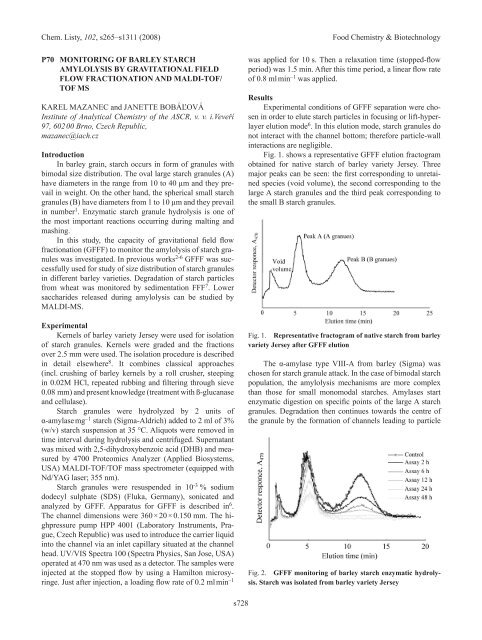3. FOOD ChEMISTRy & bIOTEChNOLOGy 3.1. Lectures
3. FOOD ChEMISTRy & bIOTEChNOLOGy 3.1. Lectures
3. FOOD ChEMISTRy & bIOTEChNOLOGy 3.1. Lectures
You also want an ePaper? Increase the reach of your titles
YUMPU automatically turns print PDFs into web optimized ePapers that Google loves.
Chem. Listy, 102, s265–s1311 (2008) Food Chemistry & Biotechnology<br />
P70 MONITORING OF bARLEy STARCh<br />
AMyLOLySIS by GRAVITATIONAL FIELD<br />
FLOw FRACTIONATION AND MALDI-TOF/<br />
TOF MS<br />
KAREL MAZAnEC and JAnETTE BOBáľOVá<br />
Institute of Analytical Chemistry of the ASCR, v. v. i.Veveří<br />
97, 602 00 Brno, Czech Republic,<br />
mazanec@iach.cz<br />
Introduction<br />
In barley grain, starch occurs in form of granules with<br />
bimodal size distribution. The oval large starch granules (A)<br />
have diameters in the range from 10 to 40 µm and they prevail<br />
in weight. On the other hand, the spherical small starch<br />
granules (B) have diameters from 1 to 10 µm and they prevail<br />
in number 1 . Enzymatic starch granule hydrolysis is one of<br />
the most important reactions occurring during malting and<br />
mashing.<br />
In this study, the capacity of gravitational field flow<br />
fractionation (GFFF) to monitor the amylolysis of starch granules<br />
was investigated. In previous works 2-6 GFFF was successfully<br />
used for study of size distribution of starch granules<br />
in different barley varieties. Degradation of starch particles<br />
from wheat was monitored by sedimentation FFF 7 . Lower<br />
saccharides released during amylolysis can be studied by<br />
MALDI-MS.<br />
Experimental<br />
Kernels of barley variety Jersey were used for isolation<br />
of starch granules. Kernels were graded and the fractions<br />
over 2.5 mm were used. The isolation procedure is described<br />
in detail elsewhere 8 . It combines classical approaches<br />
(incl. crushing of barley kernels by a roll crusher, steeping<br />
in 0.02M HCl, repeated rubbing and filtering through sieve<br />
0.08 mm) and present knowledge (treatment with ß-glucanase<br />
and cellulase).<br />
Starch granules were hydrolyzed by 2 units of<br />
α-amylase mg –1 starch (Sigma-Aldrich) added to 2 ml of 3%<br />
(w/v) starch suspension at 35 °C. Aliquots were removed in<br />
time interval during hydrolysis and centrifuged. Supernatant<br />
was mixed with 2,5-dihydroxybenzoic acid (DHB) and measured<br />
by 4700 Proteomics Analyzer (Applied Biosystems,<br />
USA) MALDI-TOF/TOF mass spectrometer (equipped with<br />
nd/YAG laser; 355 nm).<br />
Starch granules were resuspended in 10 -3 % sodium<br />
dodecyl sulphate (SDS) (Fluka, Germany), sonicated and<br />
analyzed by GFFF. Apparatus for GFFF is described in 6 .<br />
The channel dimensions were 360 × 20 × 0.150 mm. The highpressure<br />
pump HPP 4001 (Laboratory Instruments, Prague,<br />
Czech Republic) was used to introduce the carrier liquid<br />
into the channel via an inlet capillary situated at the channel<br />
head. UV/VIS Spectra 100 (Spectra Physics, San Jose, USA)<br />
operated at 470 nm was used as a detector. The samples were<br />
injected at the stopped flow by using a Hamilton microsyringe.<br />
Just after injection, a loading flow rate of 0.2 ml min –1<br />
s728<br />
was applied for 10 s. Then a relaxation time (stopped-flow<br />
period) was 1.5 min. After this time period, a linear flow rate<br />
of 0.8 ml min –1 was applied.<br />
Results<br />
Experimental conditions of GFFF separation were chosen<br />
in order to elute starch particles in focusing or lift-hyperlayer<br />
elution mode 6 . In this elution mode, starch granules do<br />
not interact with the channel bottom; therefore particle-wall<br />
interactions are negligible.<br />
Fig. 1. shows a representative GFFF elution fractogram<br />
obtained for native starch of barley variety Jersey. Three<br />
major peaks can be seen: the first corresponding to unretained<br />
species (void volume), the second corresponding to the<br />
large A starch granules and the third peak corresponding to<br />
the small B starch granules.<br />
Fig. 1. Representative fractogram of native starch from barley<br />
variety jersey after GFFF elution<br />
The α-amylase type VIII-A from barley (Sigma) was<br />
chosen for starch granule attack. In the case of bimodal starch<br />
population, the amylolysis mechanisms are more complex<br />
than those for small monomodal starches. Amylases start<br />
enzymatic digestion on specific points of the large A starch<br />
granules. Degradation then continues towards the centre of<br />
the granule by the formation of channels leading to particle<br />
Fig. 2. GFFF monitoring of barley starch enzymatic hydrolysis.<br />
Starch was isolated from barley variety jersey

















